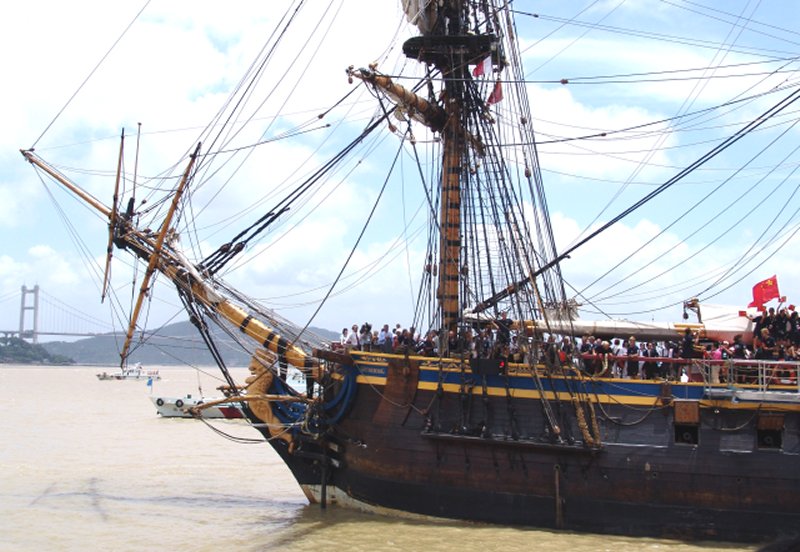


The 18th of July 2006 the Swedish East Indiaman 'Gotheborg' ship arrived to its historical docking point in the Pearl River, just outside of Whampoa and Canton (Guangzhou) in China.
The arrival was the culmination of a twenty year long private effort of excavating the original, building a replica and sailing her all the way back to China, again, following the original trade route. In the background the famous landmark Bocca Tigris, the Tiger's mouth.
CHRONOLOGYChinese Dynasties and Periods
|
Chinese civilization has a unique position in world history through its continuity through over 4,000 years to the present century. The written history of China dates back some 3,300 years.
Traditionally the northern Yellow River area has been recognized as the cradle of the Chinese civilization. However, in the last decades this view has been challenged by recent finds in the the Yangtze River (also Chang Jiang or the Yangzi) area where modern archaeological studies provide evidence of ancient cultures flourishing more than 10 000 years ago.
Chinese history until the twentieth century was meant to provide the ruler with precedents to guide his policies and justify his authority. The accounts focused on dynastic politics and colorful court histories. The historians described a Chinese political pattern of dynasties, one following another in a cycle of ascent, achievement, decay, and rebirth under a new family.
A salient trait has been the capacity of the Chinese to absorb the people of surrounding areas into their own civilization. Over the centuries Confucian scholars proved to be a resource to manage the vast country no ruler could dispose of. Since the wealth of the country was based on farming the nature itself gave very little room for experiments.
Over the ages a recurrent historical theme has been the unceasing struggle of the Chinese against the threat posed by non-Chinese peoples on the margins of their territory in the north, northeast, and northwest. In this the Great Wall can besides it military value be seen as an important tool for unifying those "inside" against those "outside".
From the earliest times The Great Wall could at times of draughts also easily keep out the grazing herds of the nomads from the cultivated river walleyes and the fields on the Chinese lowland.
In the thirteenth century, the Mongols from the northern steppes became the first alien people to conquer all of China. Although basically nomadic they left some imprint on Chinese civilization while heightening Chinese perceptions of threat from the north.
China came under alien rule for the second time in the mid-seventeenth century; the conquerors - the Manchus - came again from the north and northeast.
For thousands of years virtually all the foreigners that Chinese rulers saw came from less developed societies which conditioned the Chinese view of their domain as the center of the universe and derived from this image the traditional (and still used) Chinese name for their country - Zhongguo, the Middle Kingdom.
To understand the problems that occurred in the Chinese contacts with the rapidly industrializing Western countries one have to consider the Chinese focus on farming as the one activity that actually produced something of value, that most business of the state was run by-as well as the Emperors advisors were Confucian scholars with an age old view of the merchant class as the lowest possibly class, and the huge distance between the governmental center in the North of China and the more trade and commercially oriented Southern China.
Since most contacts with the Western powers were run with the Southern Hong merchants as middlemen, the key problem was that no tradition of contacts and understanding between China and the West ever came to be, on the ruling level.
Lacking information and understanding China took it for granted that its relations with Europeans would be conducted according to the tributary system that had evolved over the centuries between the emperor and representatives of the lesser states on China's borders as well as between the emperor and some earlier European visitors.
But by the mid-nineteenth century, humiliated militarily by superior Western weaponry and technology and faced with imminent territorial dismemberment, China began to reassess its position with respect to Western civilization. By 1911 the two-millennia-old dynastic system of imperial government was brought down by its inability to make this adjustment successfully.

Webpage © Jan-Erik Nilsson, Gothenburg, Sweden 2002-2005. Chronology table based on He Li, SF Museum of Asian Art, and Suzanne G. Valenstein, MET, New York. Where differing, the source giving most details has been given precedence.